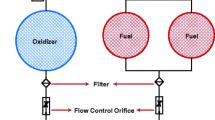Abstract
Reduction of costs is a main consideration in every space mission, and propulsion system is an important subsystem of those missions where orbital maneuvers are considered. Lighter propulsions with higher performance are necessary to reduce the mission costs. Bipropellant propulsions have been widely used in launch vehicles and upper-stages as well as deorbit modules because of better performances in comparison with other propulsion systems. Unfortunately heat transfer and thermal control limit bipropellant propulsion performance and maximum performance cannot be achieved. Well-known cooling methods such as regenerative and film cooling increase the cost using extra equipment and high temperature materials. In this paper, a new approach for cooling is presented based on combined ablative and radiative cooling. Governing equations are derived for two or three layers of thermal protection system (TPS) to optimize the TPS mass. The first layer is used as an ablative layer to control the temperature where the second and third layers are used as an insulator to control the heat fluxes. Proposed cooling method has been applied for two real bipropellant thrusters. According to the results, the presented algorithm can suitably predict the heat fluxes and satisfy the wall temperature constraint. Then, the algorithm has been used to minimize the wall temperatures as low as possible and replace high temperature materials (platinum alloy) with common materials (composite or steel). It is shown that selection of TPS materials affects the TPS mass and Isp simultaneously, but conversely. Best solution should be derived by trading off between structure temperature (cost), Isp (performance), and TPS thicknesses (geometry). Multidisciplinary approach to TPS and structure material selection of a bipropellant thruster is presented for a case study. It has been shown that mass and performance penalties of using TPS are acceptable, considering the advantages of using steel alloy instead of platinum alloy.










Similar content being viewed by others
References
Dieter K Huzel and David H Huang 1992 Modern engineering for design of liquid propellant rocket engines. 370 L’Enfant Promenade, Washington DC, American Institute of Aeronautics and Astronautics
Mo Bai 2007 Numerical evaluation of heat transfer and pressure drop in open cell foams. MSc thesis, Florida, University of Florida
Adami A 2015 Multidicsiplinary design optimization of Reentry Vehicle considering Guidance Algorithm. PhD thesis, Tehran, Iran, Amirkabir University of Technology
Matteo Trotti 2011-2012 Modelling of liquid film cooling in a GOX/Kerosene rocket combustion chamber. PhD thesis, Politecnico di Milano
Marco Pizzarelli, Francesco Nasuti and Marcello Onofri 2013 Trade-off analysis of high-aspect-ratio-cooling-channels for rocket engines, 44, pp. 458–467
Torres Y, Stefanini L and Suslov D 2009 Influence of curvature in regenerative cooling system of rocket engine 1: 171–184
Mustafa Emre Boysan 2008 Analysis of regenarative cooling in liquid propellant rocket engines, MSc Thesis, Middle East Technical University
Arnold R, Suslov D I and Haidn O J 2009 Film cooling of accelerated flow in a subscale combustion chamber. J. Propul. Power 25: 443–451
Arnold R, Suslov D I and Haidn O J 2010 Film cooling in a high-pressure subscale combustion chamber. J. Propul. Power 26: 428–438
Hessam Babaee 2013 Analysis and optimization of film cooling effectivness, PhD Thesis, Louisiana State University
Knab O, Frey M, Görgen J, Maeding C, Quering K and Wiedmann D 2009 Progress in combustion and heat transfer modelling in rocket thrust chamber applied engineering. Denver, Colorado, 45th AIAA/ASME/SAE/ASEE Joint Propulsion Conference & Exhibit
Hinckel J N, Savonov R I and Patire H 2011 Determination of thermal load in film cooled bipropellant thrust chambers by an inverse method, EUCASS 2011-421 experiments andtest facilities, 2011. 4th European conference for aerospace sciences
Heath Thomas Martin 2013 Assessment of the performance of ablative insulators under realistic solid rocket motor operating conditions, PhD thesis, The Pennsylvania State University
David J Anderson, Michelle M Munk and John Dankanich 2009 Status and mission applicability of NASA’s In-Space Propulsion Technology Project. Denver, Colorado, 45th AIAA/ASME/SAE/ASEE Joint Propulsion Conference & Exhibit
New Frontiers Program Library 2008 Advanced material bi-propellant rocket (AMBR) information summary
New Frontiers Program Library, [Online] Available at: http://newfrontiers.larc.nasa.gov/NFPL.html
Hossein Darabi, Jafar Roshanian and Hadi Zare 2014 Design of liquid-propellant engine using collaborative optimization and evolutionary algorithms, Proceedings of the Institution of Mechanical Engineers, Part G, Journal of Aerospace Engineering
Ernst R L 2014 Development of a liquid bi-propellant rocket engine design, analysis and optimization tool. MSc thesis, Delft University of Technology, Faculty of Aerospace Engineering
Amirhossein Adami, Mahdi Mortazavi and Mehran Nosratollahi 2015 A new approach in multidisciplinary design optimization of upper-stages using combined framework. ACTA Astronuatica 114: 174–183, September–October 2015 (10.5120/20496-2109)
NASA Ames, Thermal protection materials and system branch TPSX Internet Database, (NASA TPSX website: http://asm.arc.nasa.gov)
Nasa Space Vehicle Design Criteria A. 1968 Entry thermal protection
Author information
Authors and Affiliations
Corresponding author
Rights and permissions
About this article
Cite this article
ADAMI, A., MORTAZAVI, M. & NOSRATOLLAHI, M. Multidisciplinary approach to materials selection for bipropellant thrusters using ablative and radiative cooling. Sadhana 41, 87–96 (2016). https://doi.org/10.1007/s12046-015-0454-7
Received:
Revised:
Accepted:
Published:
Issue Date:
DOI: https://doi.org/10.1007/s12046-015-0454-7




